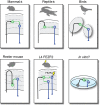Fate and freedom in developing neocortical circuits
- PMID: 28671189
- PMCID: PMC5500875
- DOI: 10.1038/ncomms16042
Fate and freedom in developing neocortical circuits
Abstract
The activity of neuronal circuits of the neocortex underlies our ability to perceive the world and interact with our environment. During development, these circuits emerge from dynamic interactions between cell-intrinsic, genetically determined programs and input/activity-dependent signals, which together shape these circuits into adulthood. Building on a large body of experimental work, several recent technological developments now allow us to interrogate these nature–nurture interactions with single gene/single input/single-cell resolution. Focusing on excitatory glutamatergic neurons, this review discusses the genetic and input-dependent mechanisms controlling how individual cortical neurons differentiate into specialized cells to assemble into stereotypical local circuits within global, large-scale networks.
Figures




Similar articles
-
Post-transcriptional regulatory elements and spatiotemporal specification of neocortical stem cells and projection neurons.Neuroscience. 2013 Sep 17;248:499-528. doi: 10.1016/j.neuroscience.2013.05.042. Epub 2013 May 30. Neuroscience. 2013. PMID: 23727006 Free PMC article. Review.
-
Lineage-dependent circuit assembly in the neocortex.Development. 2013 Jul;140(13):2645-55. doi: 10.1242/dev.087668. Development. 2013. PMID: 23757410 Free PMC article. Review.
-
Human-specific ARHGAP11B induces hallmarks of neocortical expansion in developing ferret neocortex.Elife. 2018 Nov 28;7:e41241. doi: 10.7554/eLife.41241. Elife. 2018. PMID: 30484771 Free PMC article.
-
Neuronal circuits of the neocortex.Annu Rev Neurosci. 2004;27:419-51. doi: 10.1146/annurev.neuro.27.070203.144152. Annu Rev Neurosci. 2004. PMID: 15217339 Review.
-
Phosphoinositide 3-kinase enhancer regulates neuronal dendritogenesis and survival in neocortex.J Neurosci. 2011 Jun 1;31(22):8083-92. doi: 10.1523/JNEUROSCI.1129-11.2011. J Neurosci. 2011. PMID: 21632930 Free PMC article.
Cited by
-
Maturation and circuit integration of transplanted human cortical organoids.Nature. 2022 Oct;610(7931):319-326. doi: 10.1038/s41586-022-05277-w. Epub 2022 Oct 12. Nature. 2022. PMID: 36224417 Free PMC article.
-
The Transcription Regulator Patz1 Is Essential for Neural Stem Cell Maintenance and Proliferation.Front Cell Dev Biol. 2021 Apr 7;9:657149. doi: 10.3389/fcell.2021.657149. eCollection 2021. Front Cell Dev Biol. 2021. PMID: 33898458 Free PMC article.
-
Sensory Abnormalities in Autism Spectrum Disorders: A Focus on the Tactile Domain, From Genetic Mouse Models to the Clinic.Front Psychiatry. 2020 Jan 28;10:1016. doi: 10.3389/fpsyt.2019.01016. eCollection 2019. Front Psychiatry. 2020. PMID: 32047448 Free PMC article. Review.
-
A shared transcriptional code orchestrates temporal patterning of the central nervous system.PLoS Biol. 2021 Nov 12;19(11):e3001450. doi: 10.1371/journal.pbio.3001450. eCollection 2021 Nov. PLoS Biol. 2021. PMID: 34767545 Free PMC article.
-
Functional imaging of brain organoids using high-density microelectrode arrays.MRS Bull. 2022;47(6):530-544. doi: 10.1557/s43577-022-00282-w. Epub 2022 Jun 30. MRS Bull. 2022. PMID: 36120104 Free PMC article.
References
-
- Molyneaux B. J., Arlotta P., Menezes J. R. L. & Macklis J. D. Neuronal subtype specification in the cerebral cortex. Nat. Rev. Neurosci. 8, 427–437 (2007). - PubMed
-
- Petreanu L., Mao T., Sternson S. M. & Svoboda K. The subcellular organization of neocortical excitatory connections. Nature 457, 1142–1145 (2009) This article provides the first systematic description of the subcellular input to distinct subtypes of neurons in the somatosensory cortex. - PMC - PubMed
-
- Vitali I. & Jabaudon D. Synaptic biology of barrel cortex circuit assembly. Semin. Cell. Dev. Biol. 15, 156–164 (2014). - PubMed
Publication types
MeSH terms
Substances
LinkOut - more resources
Full Text Sources
Other Literature Sources

